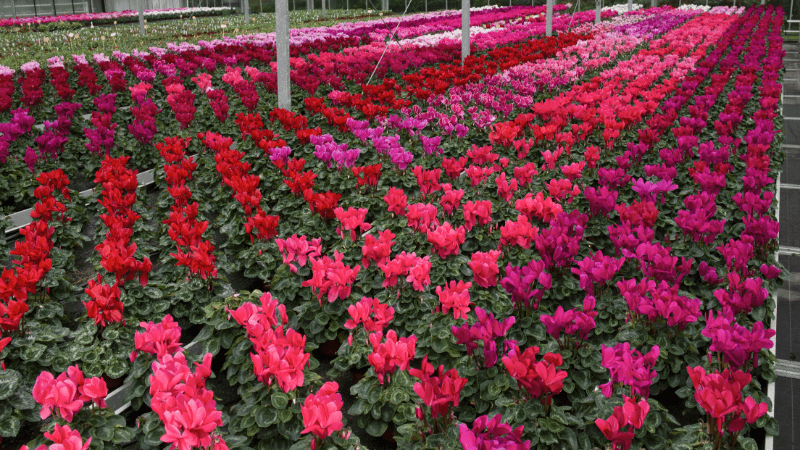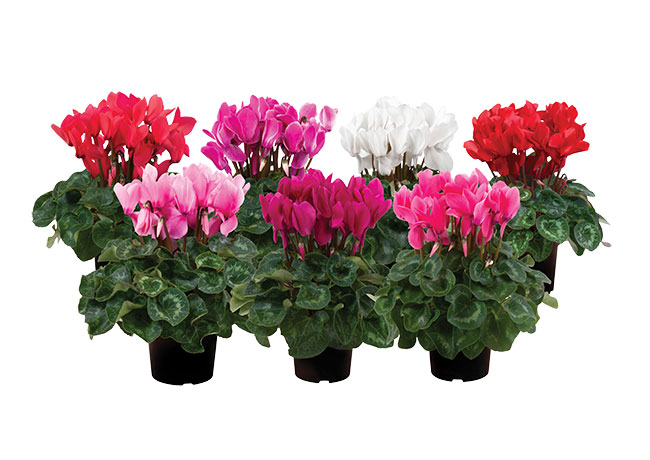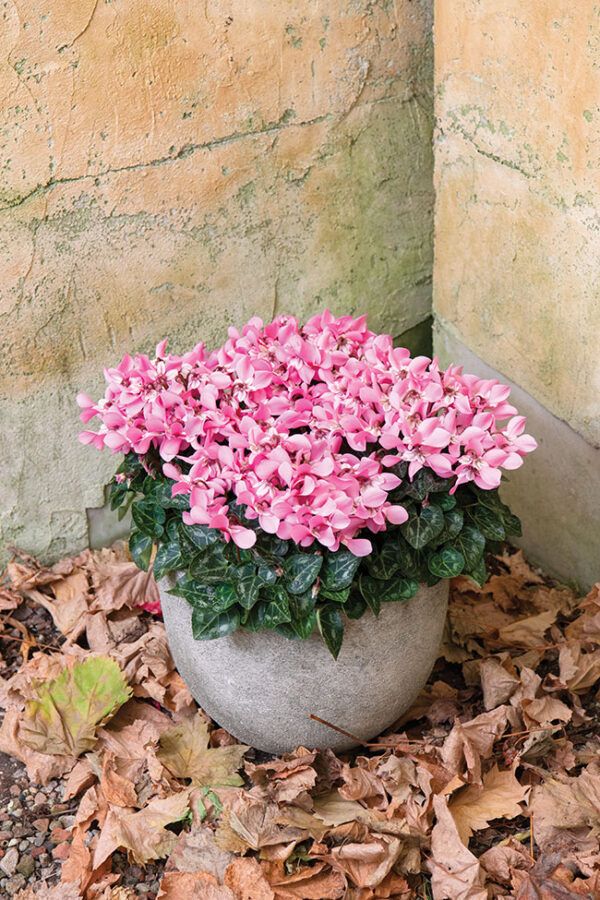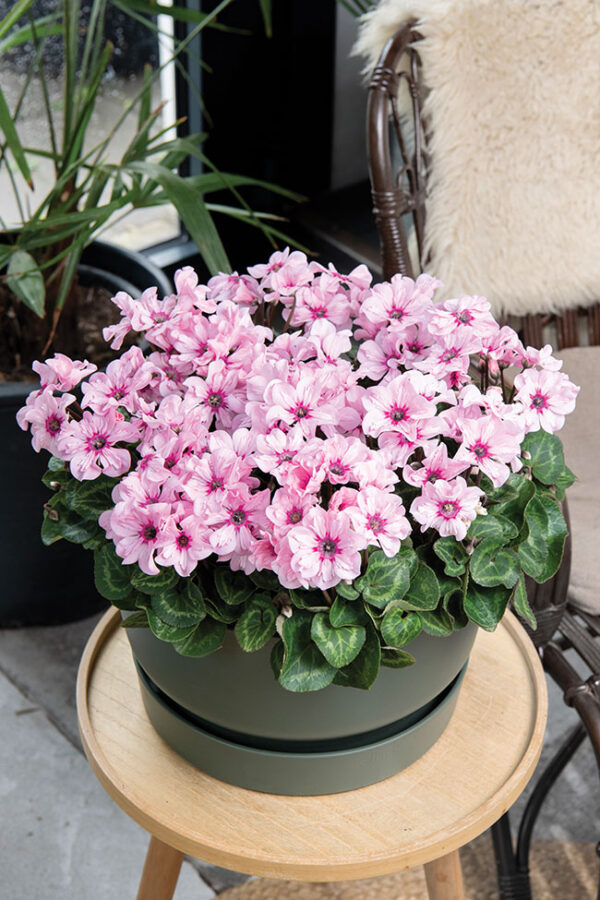
Culture Report: Cyclamen
Cyclamen have long been used as an indoor potted plant. More recently, consumers and landscapers are using this colorful yet durable plant in their gardens and borders. They also make a unique patio container planted as a monocrop or in a combination.
Schoneveld Breeding, based in Wilp, Netherlands, is a world leader in cyclamen. Established in 1930, Schoneveld offers a line of innovative cyclamen focusing on uniformity, central blooming, sturdy flower stems, rounded plant habit, abundant blooms and a long shelf life.
As a specialist in cyclamen breeding, Schoneveld has introduced some distinctive flower shapes and colors such as Djix, Fusion and Illusia.
Djix
Fusion
Illusia
One of the newest genetics is Leopardo. This large flowering series offers extremely large blooms on strong sturdy stems. It grows with little to no heat delay even during the heat of the summer. It is well suited for 4-inch, 6-inch and gallon pots and is available in 10 colors.

Next to Leopardo is the “little sister” called Elegante, with all the same great attributes of Leopardo but in a mid-size flower. Elegante is perfect for 4- and 5-inch pots.
As is true with all of the Schoneveld cyclamen, Leopardo and Elegante are bred to produce more leaves per plant. What does this mean? For every leaf, the potential for a flower is produced!
Another collection in the Super Serie cyclamen is comprised of Carino (green leaf) and Picasso (silver leaf) series. Although they perform well inside the home, these varieties are bred specifically for their endurance in the landscape. The longevity and flower power produced by this collection makes it an easy choice for the home and garden.
Many times, growers will focus on producing a crop as fast as possible in an effort to maximize space and reduce costs per square foot. Growing and finishing quality cyclamen is no different in that regard. The growing protocols for producing a quality crop of cyclamen can be summarized in three points:
- Fertilizer rates
- Moisture management
- Disease control
FERTILIZER RATES
When devising a fertilizer regime, it’s necessary to know and understand how well the plants can develop a good, vigorous root system. Therefore, in order to get the plants off to a good start — whether it’s in the plug stage or after transplanting — it’s necessary to feed the plants with a calcium nitrate-based fertilizer in order to achieve a soil EC level from 0.8-1.0, pH level of 5.5-6.0, with an optimum of 5.8. Balanced 15-3-30, 15-3-16 or 17-5-17 fertilizers are some very good formulations to consider when deciding which fertilizer blend to utilize, ensuring there’s adequate magnesium and a good minors package added in.
Once the roots are established and out to the sides and bottom of the containers, the EC levels can be lowered to 0.6-0.8 (in the soil) to maintain good, toned growth. Overfertilization will result in plants larger than desired.
MOISTURE MANAGEMENT
Irrigating cyclamen to the proper levels is essential to keep the plants growing and provide adequate nutrient uptake. Because Schoneveld cyclamen have great root systems, the plants are able to readily draw up available water. However, oversaturated media can invite root rot diseases, as well as suffocate the root system. Therefore, it’s advisable to maintain a medium, even moisture level as close as possible at all times. Plants can be allowed to dry down slightly to maintain growth control, but the plants shouldn’t flag or wilt, resulting in plant growth that may be inhibited. Remember, it’s all about more leaf production.
DISEASE CONTROL
Because cyclamen naturally have a dense canopy of foliage as they approach finishing, the air movement through the crop can be inhibited. Preventative fungicide applications should be applied to prevent Botrytis and other foliage and stem diseases. Additionally, Fusarium can be a problem, especially in plants that are watered overhead and are exposed to splashing between plants and rows. It’s highly advised to place cyclamen crops on drip tubes, capillary mats or ebb and flow benches or floors. This will greatly alleviate the incidence of diseases spreading throughout the crops.
PRODUCTION
Plug Stage – Germination
- Media pH 5.8-6.0
- Media EC 0.5-0.7
- Germination temperature 62-64° F
To achieve maximum germination and usable transplants, cover with medium-grade vermiculite — cyclamen require darkness to germinate. Water in plug trays to moisture level 5 (saturated), then wrap the trays in poly and place them in an environment of high moisture and 100% humidity. Cyclamen seeds will germinate in 21-28 days depending on the variety. After germination, place the plug trays in a shaded area of the greenhouse with overhead misting, if possible, to prevent the media from drying out. When the cotyledon has expanded, low levels of a calcium nitrate-based fertilizer can be applied for a soil EC of 0.75-1.0. An initial fertilizer blend of N:K at 1:1 is recommended (during hotter times of the year it is recommended to start the plants with a 1:3 ratio and, as the climate gets cooler, go to a 1:2). This will help reduce losses due to Fusarium at the end of the crop.
TRANSPLANT TO FINISH
- Media pH 5.8-6.0
- Media EC 0.8-1.0
- Ideal temperature 62-64° F
During warmer periods, ensure adequate air circulation over the crop and draw shade cloths during hot periods of the day. Transplant to finish growth time is 13-18 weeks depending on variety and climate. It is vital to space cyclamen on time. Optimal spacing is to place enough room so the leaves do not touch between plants. When transplanting cyclamen plugs, the corm of the micro, mini and intermediate varieties should be placed atop the soil line. The corms of the standard and jumbo varieties should be placed slightly indented into the top of the soil line. This will ensure the emerging new root systems of the transplants grow rapidly with no setbacks due to lack of oxygen and nutrients. It is also suggested to apply a preventative fungicide such as RootShield or Actinovate at the time of transplant. This will help with Pythium, Fusarium and Erwinia.
Following these protocols will ensure a beautiful finish to your cyclamen. With these tips and new genetics, cyclamen can be a great addition to your program. More detailed information is available at schoneveld-breeding.com.





 Video Library
Video Library 




















